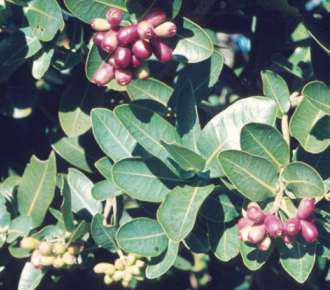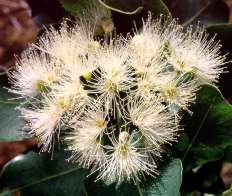Syzygium cordatum
Syzygium cordatum Hochst.ex C.Krauss.
Family: Myrtaceae
Common names: water berry (Eng.); waterbessie, waterbessieboom, waterboom, waterhout (Afr.); umdoni (Zulu); umswi, umjomi (Xhosa), mawthoo (Southern Sotho), motlho (Northern Sotho), mutu (Venda), muhlwa (Tsonga)
SA Tree No: 555
Introduction
This beautiful tree (pronounced si-zig-ee-um) is home to many birds and insects. It is invasive in the Betty's Bay area of the Western Cape.

Description
Description
An evergreen, water-loving tree, which grows to a height of 8 -15 m. This tree is often found near streams, on forest margins or in swampy spots. The leaves are elliptic to circular, bluish green on top and a paler green below. Young leaves are reddish. The white to pinkish fragrant flowers are borne in branched terminals and have numerous fluffy stamens and produce abundant nectar. It flowers from August to November. The fruits are oval berries, red to dark-purple when ripe.

Conservation Status
Status
Least Concern (LC), this species is not threatened.
Distribution and habitat
Distribution description
Syzygium cordatum occurs along streambanks from the Eastern Cape through KwaZulu-Natal and northwards to Mozambique. It grows in forest margins, in bush, in riverine thicket and forest, and in open grassy and sometimes high country. In parts of KwaZulu-Natal and Mozambique it forms stands of swamp forest.
Derivation of name and historical aspects
History
According to Pitman and Palmer (1972), the generic name Syzygium is based on a Greek word meaning 'coupled', an allusion to the paired branches and leaves.
The specific name cordatum is from the Latin word cordatus, meaning 'heart-shaped', referring to the shape of the base of the leaf.
Ecology
Ecology
According to Palmer and Pitman (1972), one of the only two nesting sites of the Woolly-necked Stork known in South Africa is in an umdoni swamp forest near Mtunzini. The foliage of this tree is eaten by Kudu and birds such as the Crowned Hornbill feed off the large hairy caterpillars that sometimes infest the tree.
Uses
Use
This tree is known for its many uses. The fleshy fruit is edible, slightly acid in flavour, and is eaten by children, monkeys, bush-babies and birds. The berries are also used to sometimes make an alcoholic drink. The powdered bark is used as a fish poison. In central Africa the tree is known as a remedy for stomach ache and diarrhoea. It is also used to treat respiratory ailments and tuberculosis.
Growing Syzygium cordatum
Grow
The tree is best grown from seed. For better germination pre-treat seed with a pre-emergance fungicide, this will prevent seedlings from dampening off before emerging above the soil. Sow seed in a seed tray filled with well-drained soil and cover seeds with a thin layer of soil. Water well and keep in a well-ventilated area. Once seed has germinated, feed seedlings with an organic liquid fertilizer. Pot seedlings into individual plant bags or pots.
As its common name suggests, this is a water-loving tree, so it is best planted in full sun near a stream or river bank or any damp area.
References
- Coates Keith, 1983, Trees of Southern Africa, second edition, Struik Publishers, Cape Town.
- Palmer Eve and Pitman Norah, 1972, Trees of Southern Africa, A.A Balkema, Cape Town.
- Van Wyk Braam and Van Wyk Piet, 1997, Field Guide to Trees of Southern Africa, Struik Publishers, Cape Town.
- Van Wyk Ben-Erik and Gericke Nigel, 2000, People's Plants A guide to Useful Plants of Southern Africa, Briza Publications, Pretoria.
- Van Wyk Ben-Erik, Van Oudtshoorn Bosch & Gericke Nigel, 1997, Medicinal Plants of South Africa, Briza Publications, Pretoria.
Credits
Berenice Carolus
Harold Porter NBG
September 2004
Plant Attributes:
Plant Type: Tree
SA Distribution: KwaZulu-Natal, Mpumalanga, Western Cape
Soil type: Sandy, Loam
Flowering season: Spring
PH: Alkaline
Flower colour: White, Pink
Aspect: Morning Sun (Semi Shade)
Gardening skill:
Special Features:
Horticultural zones









Rate this article
Article well written and informative
Rate this plant
Is this an interesting plant?
Login to add your Comment
Back to topNot registered yet? Click here to register.